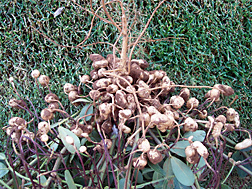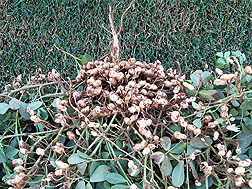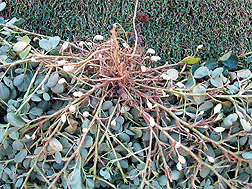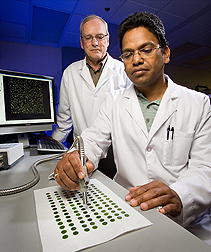Preparing Peanuts for the Future
New Cultivars and Farming Strategies
|
|
Peanuts are an important crop, contributing more than $4 billion to the country’s economy each year. But rapid growth in cities along with water level declines in aquifers throughout the South have resulted in fewer acres for farming and less water available for irrigation. To meet future food-supply demands, crop production will have to increase, but it must do so under the constraints of less water and, most likely, less farm land.
Agricultural Research Service scientists with the Plant Stress and Germplasm Development Research Unit in Lubbock, Texas, and the National Peanut Research Laboratory (NPRL) in Dawson, Georgia, are working with cooperators to help peanut farmers maintain and improve their production in a changing environment.
Managing Abiotic Stresses
At the Lubbock laboratory, plant physiologist Paxton Payton and postdoctoral research associate Rao Kottapalli are examining molecular mechanisms involved in peanut response to abiotic stress. Abiotic stress is the negative effect that nonliving factors, such as drought and heat, have on living organisms.
|
|
The researchers recently conducted groundbreaking work aimed at linking responses at the molecular level to the physiology and yields in peanut plants. They examined the proteins, particularly their expression, that control drought stress in peanut.
To examine diverse peanut germplasm more efficiently, Payton and Kottapalli performed greenhouse and molecular screening of 70 genotypes from the U.S. peanut mini-core collection and 7 additional cultivars representing varieties commonly grown in the southern United States and semiarid regions in Asia. The mini-core collection—developed by ARS plant breeder Corley Holbrook in Tifton, Georgia—consists of 112 peanut accessions that represent most of the variation present in the larger collection of peanut germplasm.
Field screening of the accessions was performed by New Mexico State University scientist Naveen Puppala and a team of Texas AgriLife Research and Texas Tech University scientists led by Mark Burow. Photosynthetic measurements of the field-grown plants by Payton and Kottapalli helped narrow down the group to two accessions that are highly tolerant to heat and drought and two that are highly susceptible.
|
|
This follows previous work by the AgriLife and Texas Tech scientists and ARS scientists John Burke and Gloria Burow, who demonstrated heat and drought tolerance in a smaller set of peanut germplasm. They are now examining the inheritance of abiotic stress tolerance and hope to develop molecular markers that can be useful in breeding.
“Identifying drought responses in the mini-core collection can help us determine potential genetic components involved in abiotic stress tolerance,” says Payton. “Our study identifies potential targets for breeding and genetic engineering of abiotic stress tolerance in peanut crop plants.”
Perhaps most importantly, the phenotypes Payton and Kottapalli identified in the screening process were confirmed by field trials under stress-inducing conditions. Puppala and Burow are using the results of this and other screening experiments to make crosses to improve abiotic stress tolerance in peanut.
Payton and the researchers are also testing peanut’s response to other abiotic stresses. In recent tests, they found that the most heat-tolerant accessions were also the most drought tolerant. They also plan to build on previous salt-stress work by AgriLife and Texas Tech scientists and conduct low-temperature screenings and tests in the coming year.
|
|
Developing New Farming Techniques
NPRL agronomist Wilson Faircloth and plant stress physiologist Diane Rowland (formerly with NPRL and now with Texas AgriLife Research) conducted field trials for 5 years in west Texas to determine the effects of deficit irrigation and, more recently, conservation tillage on peanut performance.
“Under deficit-irrigation management early in the season, plants appeared to reach maturity sooner than under late-season or other water deficits, and they maintained their yields,” says Faircloth. “Exposure to induced early-season drought may acclimate the crop to the drought stress that commonly occurs during late-season growth.”
It is also during this latter part of the growing season that growers typically experience water deficits due to reduced pumping capacity, further increasing the risk of yield loss.
“We wanted to find out whether conservation tillage with a cover crop could be used as an additional drought-mitigation tool,” says Faircloth. “To do this, we did a field study to compare traditional, high-intensity tillage to conservation tillage with a rye cover crop.”
To be sure the research would hold up under grower conditions, the scientists tested it in one half of a center-pivot irrigation system located in Lubbock, Texas. They subdivided it into six half-acre sections and applied varying amounts of water to peanut and cotton planted in either conservation or conventional tillage.
“We used varying amounts of water to simulate a range of conditions—from normal season-long irrigation to early-season drought to late-season drought,” says Faircloth. Irrigation treatments were done in the traditional manner (meeting 100 percent of the water need) and to simulate early-season drought (50 percent of the full amount for the first 45 days after crop emergence) and late-season drought (50 percent of the full amount for the 45 days before harvest). Soil conditions and plant physiological responses were intensively monitored in the test areas. These included soil water content, plant photosynthetic rates, metabolic fitness, soil and canopy temperatures, rooting patterns, and tissue collections for genomic expression.
“Conservation tillage in the form of strip tillage was successfully demonstrated in this series of field tests, a first for peanut in this region,” says Faircloth. Additionally, under deficit irrigation, strip tillage increased yield when compared to conventional tillage. “This yield increase was attributed to increased water-holding capacity of the soil and changes in peanut rooting patterns. The combination of conservation tillage and deficit irrigation promotes conservation of water during the early season, and if implemented over a large geographic area such as the Southern High Plains, it has potential to significantly affect late-season water issues by reducing the amount of water needed for peanut irrigation.”
With more research, ARS will be able to help peanut farmers prepare for changes in the environment, which will help keep this delicious and nutritious legume available for generations to come.—By Stephanie Yao and Sharon Durham, Agricultural Research Service Information Staff.
This research is part of Agricultural System Competitiveness and Sustainability (#216), Plant Biological and Molecular Processes (#302), and Quality and Utilization of Agricultural Products (#306), three ARS national programs described at www.nps.ars.usda.gov.
To reach scientists mentioned in this article, contact Stephanie Yao, USDA-ARS Information Staff, 5601 Sunnyside Ave., Beltsville, MD 20705-5129; (301) 504-1619.
"Preparing Peanuts for the Future: New Cultivars and Farming Strategies" was published in the January 2010 issue of Agricultural Research magazine.











